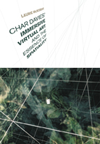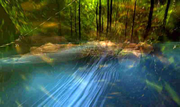November 13, 2006
Char Davies

Immersive Virtual Art and the Essence of Spatiality
Char Davies' Immersive Virtual Art and the Essence of Spatiality by Laurie McRobert :: In this first book-length study of the internationally renowned Canadian artist Char Davies, Laurie McRobert examines the digital installations Osmose and Ephémère in the context of Davies’ artistic and conceptual inspirations. Davies, originally a painter, turned to technology in an effort to create the effect of osmosis between self and world. By donning a head-mounted display unit and a body vest to monitor breathing and balance, participants are immersed in 3D-virtual space where they interact with abstract images of nature while manoeuvring in an artificial spatial environment.
Char Davies’ Immersive Virtual Art and the Essence of Spatiality explores spatiality through a broad scope of disciplines, including philosophy, mythology, biology, and visual studies, in order to familiarize the reader with virtual reality art – how it differs from traditional artistic media and why immersive virtual art promises to expand our imaginative horizons. This original study provides us with an important exposition of two of Char Davies’ acclaimed projects and an exploration of the future impact of digital virtual art on our worldviews.
Laurie McRobert is an independent scholar and a former lecturer in the Department of Philosophy at McGill University and the Thomas More Institute for Adult Education.

Virtual Space
"What I am trying to translate to you is more mysterious; it is entwined in the very roots of being, in the impalpable source of sensations." - J. Gasquet, Cezanne, quoted by Merleau-Ponty, 'Eye and Mind'.
I have been working in "virtual space" for nearly 10 years, and during that time have produced two major works, the virtual environments Osmose (1995) and Ephémère (1998) [1]. Integrating full body immersion, interactive 3-D digital imagery and sound, and navigation via a breathing interface, these works embody a radically alternative approach to immersive virtual space, or what is commonly known as "virtual reality" or "VR". Rather than approaching the medium as a means of escape into some disembodied techno-utopian fantasy, I see it as a means of return, i.e. of facilitating a temporary release from our habitual perceptions and culturally-biased assumptions about being in the world, to enable us, however momentarily, to perceive ourselves and the world around us freshly.
[1] Osmose (1995) and Ephémère (1998) were constructed with the dedicated participation of the following individuals: John Harrison, custom programming; Georges Mauro, graphics; Dorota Blaszczak, 3-D sonic architecture; and Rick Bidlack, sound composition.
It should be noted that when I say virtual space, I am referring to immersive virtual space, i.e. a computer-generated artificial environment that one can seemingly, with the aid of various devices, go inside. I think of virtual space as a spatiotemporal "arena" wherein mental models or abstract constructs of the world can be given virtual embodiment (visual and aural) in three dimensions and be animated through time. Most significantly, these can then be kinesthetically explored by others through full body immersion and real-time interaction, even while such constructs retain their immateriality. Immersive virtual space is thus a philosophical and a participatory medium, a unique convergence in which the immaterial is confused with the bodily-felt, and the imaginary with the strangely real. This paradox is its most singular power. The firsthand experience of being bodily immersed in its all-encompassing spatiality is key: when combined with its capacity for abstraction, temporality, and interaction, and when approached through an embodying interface, immersive virtual space becomes a very potent medium indeed.
Between 1995 and 2001, more than 20,000 people have been individually immersed in the virtual environments Osmose and Ephémère. A common response to the experience is one of astonishment: many "immersants" have described their experience in euphoric terms while others have inexplicably wept. As one participant wrote six months afterwards: '[This experience] heightened an awareness of my body as a site of consciousness and of the experience and sensation of consciousness occupying space. It's the most evocative exploration of the perception of consciousness that I have experienced since I can’t remember when.'
Such responses suggest that immersive virtual space, when approached in an unconventional way, can indeed provide a means of perceiving freshly. The medium’s paradoxical qualities may effectively be usedto redirect attention from our usual distractions and assumptions to the sensations of our own condition as briefly embodied sentient beings immersed in the flow of life through space and time." Continue reading Virtual Space by Char Davies. Published in SPACE in Science, Art and Society. François Penz, Gregory Radick and Robert Howell, eds.; Cambridge, England: Cambridge Universty Press (2004), pp. 69-104, illus.
Posted by jo at November 13, 2006 05:33 PM
